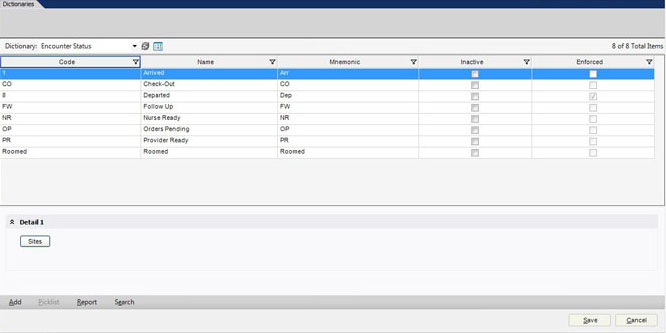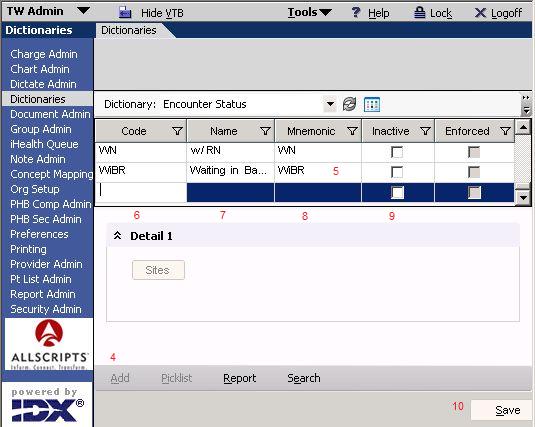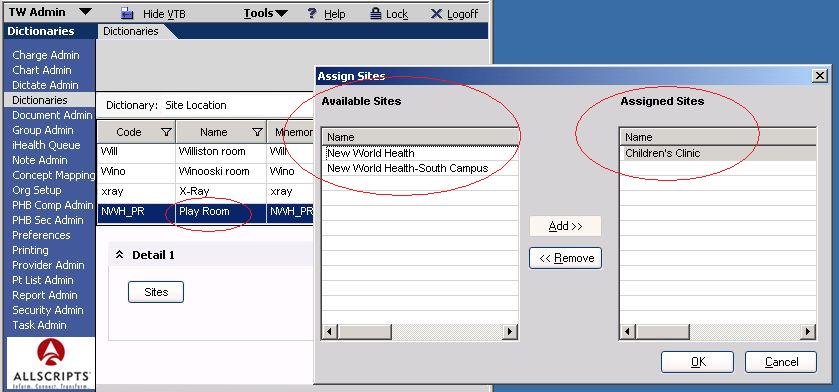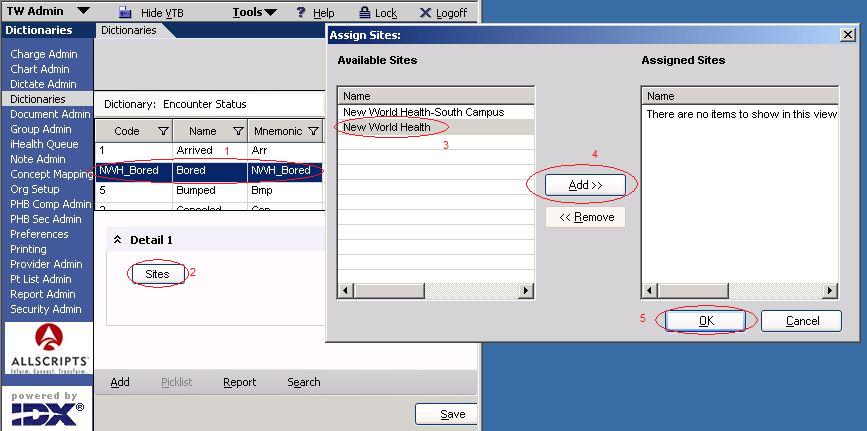Difference between revisions of "Creating Patient Location and Patient Status information"
Steve.Stahr (talk | contribs) |
Callie.moore (talk | contribs) |
||
| Line 3: | Line 3: | ||
The '''Patient Site Location''' field allows a user to select, track and communicate the physical location for a patient | The '''Patient Site Location''' field allows a user to select, track and communicate the physical location for a patient | ||
* Examples of Patient Locations are: Waiting Room, Check In, Exam Room 1, Lab | * Examples of Patient Locations are: Waiting Room, Check In, Exam Room 1, Lab | ||
| − | * Organizations can name the patient locations however they wish | + | * Organizations can name the patient locations however they wish, but should attempt to find a cohesive naming convention across the organization (such as Exam Room 1, Exam Room 2). This may require input from clinical staff in order to define logical, appropriate names. |
* Organizations must assign their locations to Sites so that each Site sees only locations at that site. If a location is not assigned to a site it will not appear in the dropdown | * Organizations must assign their locations to Sites so that each Site sees only locations at that site. If a location is not assigned to a site it will not appear in the dropdown | ||
* The Pt Loc is assigned to the PATIENT in context. It is not specific to the encounter, date or site. If the Pt Loc is set at one site, another site will see this Location value even if it is not assigned to that site. However, the dropdown values will only consist of the Locations assigned to that site. | * The Pt Loc is assigned to the PATIENT in context. It is not specific to the encounter, date or site. If the Pt Loc is set at one site, another site will see this Location value even if it is not assigned to that site. However, the dropdown values will only consist of the Locations assigned to that site. | ||
Revision as of 19:50, 15 December 2010
Overview
The Patient Site Location field allows a user to select, track and communicate the physical location for a patient
- Examples of Patient Locations are: Waiting Room, Check In, Exam Room 1, Lab
- Organizations can name the patient locations however they wish, but should attempt to find a cohesive naming convention across the organization (such as Exam Room 1, Exam Room 2). This may require input from clinical staff in order to define logical, appropriate names.
- Organizations must assign their locations to Sites so that each Site sees only locations at that site. If a location is not assigned to a site it will not appear in the dropdown
- The Pt Loc is assigned to the PATIENT in context. It is not specific to the encounter, date or site. If the Pt Loc is set at one site, another site will see this Location value even if it is not assigned to that site. However, the dropdown values will only consist of the Locations assigned to that site.
- Pt Locations are designed to be cleared out by a nightly process.
- Preferences name: Patient Site Location
- UI name: Pat Loc
- Dictionary name: Site Location (not Patient Location)
- SSMT category: Site Location (not Patient Location)
The Patient Encounter Status field identifies the various statuses of a patient office visit.
- Examples of Status are: Arrived, No Show, Cancelled, Bumped, Departed
- Organizations can name the patient locations however they wish and create as many as they need, but they cannot make inactive the status 'Departed' because it is used by the system
- Organizations must assign their statuses to Sites. A Status can be assigned to all sites, some sites or one site. If a status is not assigned to a site it will not appear in the dropdown
- Preferences name: Patient Encounter Status
- UI name: Status
- Dictionary name: Encounter Status
- SSMT category: Encounter Status
High Level Process for New or Upgrade
Locations, Statuses, and Sites can be collected prior test upgrade
- Extract Site, Site Location and Encounter Status categories from SSMT
- Paste Site Location and Encounter Status into BW
- Client populates both tables
- Load into test environment
- Client validates in test
- Load from test into live
Create Entries for Patient Location or Status - SSMT
Note: Entries can be edited or made inactive but cannot be removed from the dictionary. Have your Location, Status and Site information organized and validated before proceeding. Review the existing entries and decide if there are any you want to overwrite or make temporarily inactive.
- Extract SSMT category 'Site' for reference
- Extract SSMT category 'Site Location' or 'Encounter Status'
- ! Do not select the 'Patient Location' category. This is used by the registration & scheduling interface to track inpatient location
- 'Site Location' and 'Encounter Status' categories were added to SSMT later and are not in alphabetical order. They are near the bottom.
- Paste into the Site Location Spreadsheet in the Build Workbook
- To eliminate an existing entry replace the existing values with one of your new entries. If you have no new entry to replace it with, set 'Inactive' to 'Y'
- Enter Code: must be unique, 10 characters or less, start with Org mnemonic, example 'NWH_Rm1' or 'NWH_Arr'
- Enter Name: as it should appear in dropdown
- Enter Mnemonic: match CODE exactly
- Enter Sequence: number the locations in the order you'd like them to appear in the patient location drop-down in the clinical toolbar.
- Enter SITE CODE: Must match entry in SITE dictionary exactly
- Enter SITE NAME: Must match entry in SITE dictionary exactly
- Example: New World Health has 2 sites North and South. Both sites have rooms 1-3. The Site Location table would need 6 entries, rooms 1-3 with site code and name for South and rooms 1-3 with site code and name for North.
- Set 'Create New' value to Y for all entries to be created
- If there are delivered or existing entries that need to be made temporarily inactive, set 'Inactive' to 'Y'
- Do Not Load until you are certain of all your entries, spelling etc… Once loaded, entries can be edited or made inactive but cannot be removed from the dictionary.
Create Entries for Patient Location or Status - Manual
Note: Entries can be edited or made inactive but cannot be removed from the dictionary. Have your Location, Status and Site information organized and validated before proceeding. Review the existing entries and decide if there are any you want to overwrite or make temporarily inactive.
- Log in to TouchWorks as a user with access to the TW Setup or TWAdmin VTB
- Click on TW Setup or TWAdmin > Dictionaries
- Click on the Dictionary drop down Menu and chose SITE LOCATION to work with the 'Pat Loc' drop down or ENCOUNTER STATUS to work with the 'Status' drop down.
- ! Do not select the 'Patient Location' dictionary. This is used by the registration & scheduling interface to track inpatient location
- Click ADD and a new line will be created for you to add your entry.
- To eliminate an existing entry replace the existing values with one of your new entries. If you have no new entry to replace it with, check the inactive box.
- Enter Code: must be unique, 10 characters or less, start with Org mnemonic, example 'NWH_Rm1' or 'NWH_Arr'
- Enter Name: as it should appear in dropdown
- Enter Mnemonic: match CODE exactly
- If there are delivered or existing entries that need to be made temporarily inactive, Check 'Inactive'
- The Status 'Departed' cannot be made inactive. It is used by the system
- Do Not SAVE until you are certain of all your entries, spelling etc… Once you hit SAVE, entries can be edited or made inactive but cannot be removed from the dictionary.
Assign Location or Status Entries to Site(s)
Example
- If New World Health has 3 Sites and the Site Location 'Playroom' is located at the Children's Clinic Site, Assign Site Location 'Playroom' to the Children's Clinic Site only.
- If the entry I added applied to more than one Site, I would assign the newly loaded entry to those sites as well
- Only entries assigned to the same site as the user will be available in their drop down menu
- Even if an organization only has one site, all the entries still need to be assigned to that site
- An entry not assigned to any sites will not be visible in the dropdown
Steps
- In the Site Location or Encounter Status Dictionary, highlight an entry
- Click the 'Sites' button to assign the entry to a site or sites
- Highlight a site in the Available Sites pane
- Click 'Add' to move it over to the ASSIGNED SITE pane
- Click 'Remove' to remove assigned sites from the entry
- Click OK
Set Preferences
- Log in to TouchWorks as a user with access to the TW Setup VTB
- Click on TW Setup > Preferences
- Set 'Patient Tracking – Use Patient Site Location' to Y
- Set 'Patient Tracking – Use Patient Encounter Status' to Y
- When preferences are set to N, Pat Loc: and/or Status: are grayed out in the user interface
Validate In UI
- Log in as a user
- A patient must be in context to see Pat Loc and Status values
- The Pat Loc and Status values should be visible in Schedule/Daily and Provider Schedules
- The Pat Loc and Status values should be editable in the Clinical Toolbar and the Encounter Summary
- All the entries assigned to the user's Site should be visible in the dropdowns
There are three ways to remove an entry from the dropdown menu. See the sections above for detailed steps.
- Replace it with a new entry, by editing the 'Code', 'Name' and 'Mnemonic' in the dictionary
- see Create Entries for Patient Location or Status - SSMT
- see Create Entries for Patient Location or Status - Manual
- Make it inactive for all Sites by checking the 'Inactive' box or setting 'Inactive' to Y in SSMT
- (The entry can be reativated at any time by unchecking the box or removing the Y)
- see Create Entries for Patient Location or Status - SSMT
- see Create Entries for Patient Location or Status - Manual
- Remove it from a Site
- see Assign Location or Status Entries to Site(s)





